New Perspectives on Excavation Disturbance Zones: Main Driving Forces
Abstract
1. Introduction
2. Numerical Methodology
2.1. Humidity–Stress–Damage Coupling Model
2.2. Thermo-Mechanical Coupling Model with Damage Evolution
3. Influence of Humidity Factor
3.1. Model Establishment
3.2. Analysis of Simulation Results
3.2.1. No-Load Condition
3.2.2. Load Condition
4. Influence of Temperature Factor
4.1. Model Establishment
4.2. Analysis of Simulation Results
4.2.1. No-Load Condition
4.2.2. Load Condition
5. Discussion
5.1. Environment–Stress–Damage Coupling Model and Stress Boundary Conditions
5.2. Formation Process of the EDZ with Time-Dependent Properties
5.3. EDZ and Its Actual Depth under Low Confining Pressure
6. Conclusions
- (1)
- Under no-load conditions, an EDZ is formed, which expands gradually along with the propagation of environmental factors in the rock mass. Therefore, environmental factors are the driving forces for the formation of the EDZ.
- (2)
- Under no-load conditions, the rock mass in the EDZ is mainly dominated by the deterioration of the material properties and is accompanied by slight damage. Under load conditions, the rock mass in the EDZ is destroyed in a large area; furthermore, the speed and extent of damage are significantly larger than those under no-load conditions, and the depth of the EDZ is significantly larger than that under no-load conditions. However, in the case of the isolation of environmental factors, the depth of the EDZ and the damage extent of the rock mass are significantly reduced. This confirms that environmental factors are the main driving forces for the formation of the EDZ (this is the new perspective on EDZs, as obtained in this study).
- (3)
- The deterioration of the rock mass material properties caused by the propagation of environmental factors in the rock mass is found to be a process related to time and space, from which the time-dependent properties of the EDZ originate. Under a low confining pressure or even without confining pressure, the deterioration of the rock mass material properties, related stress fields, and additional deformation caused by environmental factors are the fundamental causes for the formation of the EDZ.
- (4)
- The numerical simulation method considering environmental factors accurately reproduced the EDZ phenomenon, which was in good agreement with the actual on-site conditions, thus revealing the internal mechanism of the formation of the EDZ. The findings provide a theoretical basis for the further development of the support theory of the EDZ. Furthermore, several phenomena that could not be explained by the existing support theory of the EDZ were determined individually in this study, which provides a new idea for future research on EDZs.
Author Contributions
Funding
Institutional Review Board Statement
Informed Consent Statement
Data Availability Statement
Acknowledgments
Conflicts of Interest
References
- Dong, F.T.; Guo, Z.H.; Lan, B. The theory of supporting broken zone in surrounding rock. J. China Univ. Min. Technol. 1991, 2, 64–71. [Google Scholar]
- Dong, F.T.; Song, H.W.; Guo, Z.H.; Lu, S.M.; Liang, S.J. Roadway support theory based on broken rock zone. J. China Coal. Soc. 1994, 19, 21–32. (In Chinese) [Google Scholar]
- Jing, H.W.; Fu, G.B.; Guo, Z.H. Measurement and analysis of influential factors of broken zone of deep roadways and study on its control technique. Chin. J. Rock. Mech Eng. 1999, 18, 70–74. (In Chinese) [Google Scholar]
- Fakhimi, A.; Carvalho, F.C.; Ishida, T.; Labuz, J.F. Simulation of failure around a circular opening in rock. Int. J. Rock Mech. Min. Sci. 2002, 39, 507–515. [Google Scholar] [CrossRef]
- Golshani, A.; Oda, M.; Okui, Y.; Takemura, T.; Munkhtogoo, E. Numerical simulation of the excavation damaged zone around an opening in brittle rock. Int. J. Rock Mech. Min. Sci. 2007, 44, 835–845. [Google Scholar] [CrossRef]
- Bao, H.; Zhang, K.K.; Yan, C.G.; Lan, H.X.; Wu, F.Q.; Zheng, H. Excavation damaged zone division and time-dependency deformation prediction: A case study of excavated rock mass at Xiaowan Hydropower Station. Eng. Geol. 2020, 272, 105668. [Google Scholar] [CrossRef]
- Zhou, J.W.; Yang, X.G.; Li, H.T. Analysis of excavation damaged zone of auxiliary tunnel based on field wave velocity test at the Jinping hydropower station. In Proceedings of the Rock Mechanics: Achievements and Ambitions—2nd ISRM International Young Scholars’ Symposium on Rock Mechanics, Beijing, China, 14–16 October 2011; pp. 82–88. [Google Scholar]
- Tang, S.B.; Yu, C.Y.; Tang, C.A. Numerical modeling of the time-dependent development of the damage zone around a tunnel under high humidity conditions. Tunn. Undergr. Space Technol. 2018, 76, 48–63. [Google Scholar] [CrossRef]
- Read, R.S. 20 years of excavation response studies at AECL’s Underground Research Laboratory. Int. J. Rock Mech. Min. Sci. 2004, 41, 1251–1275. [Google Scholar] [CrossRef]
- Bossart, P.; Trick, T.; Meier, P.M.; Mayor, J. Structural and hydrogeological characterisation of the excavation-disturbed zone in the Opalinus Clay (Mont Terri Project, Switzerland). Appl. Clay Sci. 2004, 26, 429–448. [Google Scholar] [CrossRef]
- Falls, S.D.; Young, R.P. Acoustic emission and ultrasonic-velocity methods used to characterise the excavation disturbance associated with deep tunnels in hard rock. Tectonophysics 1998, 289, 1–15. [Google Scholar] [CrossRef]
- Kim, H.M.; Rutqvist, J.; Jeong, J.H.; Choi, B.H.; Ryu, D.Y.; Song, W.K. Characterizing excavation damaged zone and stability of pressurized lined rock caverns for underground compressed air energy storage. Rock Mech. Rock Eng. 2013, 46, 1113–1124. [Google Scholar] [CrossRef]
- Azit, R.; Ismail, M.A.M.; Jiang, T.Y. Evaluation of Spalling Fallout on Excavation Disturbed Zone under Deep Hard Rock Tunnel. IOP Conference Series: Materials Science and Engineering. IOP Publ. 2017, 226, 012071. [Google Scholar]
- Perras, M.A.; Diederichs, M.S. Predicting excavation damage zone depths in brittle rocks. J. Rock. Mech Geotech. Eng. 2016, 8, 60–74. [Google Scholar] [CrossRef]
- Diederichs, M.S. The 2003 Canadian Geotechnical Colloquium: Mechanistic interpretation and practical application of damage and spalling prediction criteria for deep tunnelling. Can. Geotech. J. 2007, 44, 1082–1116. [Google Scholar] [CrossRef]
- Martin, C.D.; Kaiser, P.K.; McCreath, D.R. Hoek-Brown parameters for predicting the depth of brittle failure around tunnels. Can. Geotech. J. 1999, 36, 136–151. [Google Scholar] [CrossRef]
- Hou, Z. Mechanical and hydraulic behavior of rock salt in the excavation disturbed zone around underground facilities. Int. J. Rock Mech. Min. Sci. 2003, 40, 725–738. [Google Scholar] [CrossRef]
- Hudson, J.A.; Backstrom, A.; Rutqvist, J.; Jing, L.; Backers, T.; Chijimatsu, M.; Shen, B. Characterising and modelling the excavation damaged zone in crystalline rock in the context of radioactive waste disposal. Eng. Geol. 2009, 57, 1275–1297. [Google Scholar] [CrossRef]
- Lisjak, A.; Garitte, B.; Grasselli, G.; Muller, H.; Vietor, T. The excavation of a circular tunnel in a bedded argillaceous rock (Opalinus Clay): Short-term rock mass response and FDEM numerical analysis. Tunn. Undergr. Space Technol. 2015, 45, 227–248. [Google Scholar] [CrossRef]
- Lisjak, A.; Tatone, B.S.A.; Mahabadi, O.K.; Grasselli, G.; Marschall, P.; Lanyon, G.W.; Vaissière, R.D.L.; Shao, H.; Leung, H.; Nussbaum, C. Hybrid finite-discrete element simulation of the EDZ formation and mechanical sealing process around a microtunnel in Opalinus Clay. Rock Mech. Rock Eng. 2016, 49, 1849–1873. [Google Scholar] [CrossRef]
- Cai, M.; Kaiser, P.K. Assessment of excavation damaged zone using a micromechanics model. Tunn. Undergr. Space Technol. 2005, 20, 301–310. [Google Scholar] [CrossRef]
- Kelsall, P.C.; Case, J.B.; Chabannes, C.R. Evaluation of excavation-induced changes in rock permeability. Int. J. Rock Mech. Min. Sci. Geomech. Abstr. 1984, 21, 123–135. [Google Scholar] [CrossRef]
- Zhu, W.C.; Bruhns, O.T. Simulating excavation damaged zone around a circular opening under hydromechanical conditions. Int. J. Rock Mech. Min. Sci. 2008, 45, 815–830. [Google Scholar] [CrossRef]
- Chen, Y.F.; Zheng, H.K.; Wang, M.; Hong, J.M.; Zhou, C.B. Excavation-induced relaxation effects and hydraulic conductivity variations in the surrounding rocks of a large-scale underground powerhouse cavern system. Tunn. Undergr. Space Technol. 2015, 49, 253–267. [Google Scholar] [CrossRef]
- Li, L.C.; Liu, H.H. EDZ formation and associated hydromechanical behaviour around ED-B tunnel: A numerical study based on a two-part Hooke’s model (TPHM). KSCE J. Civ. Eng. 2015, 19, 318–331. [Google Scholar] [CrossRef]
- Zhang, P.; Du, X.L.; Lu, D.C.; Jin, L.; Qi, J.L. Study on the Excavation Disturbed Zone During Tunneling in Sandy Cobble Stratum Considering the Material Meso-structure. Transport. Geotech. 2021, 29, 100590. [Google Scholar] [CrossRef]
- Li, Z.L.; Wu, R.X.; Li, L.J.; Wang, X.Y. Method for defining the loose zone of tunnel surrounding rock based on damage theory. Chin. J. Undergr. Space Eng. 2011, 7, 1060–1064, 1090. (In Chinese) [Google Scholar]
- Wang, R.; Deng, X.H.; Meng, Y.Y.; Yuan, D.Y.; Xia, D.H. Case Study of Modified H–B Strength Criterion in Discrimination of Surrounding Rock Loose Circle. KSCE J. Civ. Eng. 2019, 23, 1395–1406. [Google Scholar] [CrossRef]
- Zhang, X.D.; Feng, G.; Xu, J.L. The fractal characteristics of wall rock crack in the soft rock roadway and study on theory of loose ring. Advanced Materials Research. Trans. Tech. Publ. 2012, 396–398, 2494–2498. [Google Scholar]
- Li, H.B.; Liu, M.C.; Xing, W.B.; Shao, S.; Zhou, J.W. Failure mechanisms and evolution assessment of the excavation damaged zones in a large-scale and deeply buried underground powerhouse. Rock Mech. Rock Eng. 2017, 50, 1883–1900. [Google Scholar] [CrossRef]
- Tang, B.; Cheng, H.; Tang, Y.Z.; Yao, Z.S.; Li, M.J.; Zheng, T.L.; Lin, J. Excavation damaged zone depths prediction for TBM-excavated roadways in deep collieries. Environ. Earth Sci. 2018, 77, 165. [Google Scholar] [CrossRef]
- Yang, J.H.; Jiang, Q.H.; Zhang, Q.B.; Zhao, J. Dynamic stress adjustment and rock damage during blasting excavation in a deep-buried circular tunnel. Tunn. Undergr. Space Technol. 2018, 71, 591–604. [Google Scholar] [CrossRef]
- Yang, J.H.; Dai, J.H.; Yao, C.; Jiang, S.H.; Zhou, C.B.; Jiang, Q.H. Estimation of rock mass properties in excavation damage zones of rock slopes based on the Hoek-Brown criterion and acoustic testing. Int. J. Rock Mech. Min. Sci. 2020, 126, 104192. [Google Scholar] [CrossRef]
- Tang, S.B.; Tang, C.A. Numerical studies on tunnel floor heave in swelling ground under humid conditions. Int. J. Rock Mech. Min. Sci. 2012, 55, 139–150. [Google Scholar] [CrossRef]
- Huang, X.; Tang, S.B.; Tang, C.A.; Xie, L.M.; Tao, Z.Y. Numerical simulation of cracking behavior in artificially designed rock models subjected to heating from a central borehole. Int. J. Rock Mech. Min. Sci. 2017, 98, 191–202. [Google Scholar] [CrossRef]
- Li, L.C.; Tang, C.A.; Tang, S.B.; Lindqvist, P.-A. Research on TM coupling numerical model with damage evolution and its application. Chin. J. Theor Appl. Mech. 2006, 38, 505–513. (In Chinese) [Google Scholar]
- Tang, S.B.; Tang, C.A.; Zhu, W.C.; Wang, S.H.; Yu, Q.L. Numerical investigation on rock failure process induced by thermal stress. Chin. J. Rock Mech. Eng. 2006, 25, 2071–2078. (In Chinese) [Google Scholar]
- Tang, S.B.; Tang, C.A. Crack propagation and coalescence in quasi-brittle materials at high temperatures. Eng. Fract. Mech. 2015, 134, 404–432. [Google Scholar] [CrossRef]
- Tang, S.B.; Zhang, H.; Tang, C.A.; Liu, H.Y. Numerical model for the cracking behavior of heterogeneous brittle solids subjected to thermal shock. Int. J. Solids Struct. 2016, 80, 520–531. [Google Scholar] [CrossRef]
- Kim, J.K.; Lee, C.S. Moisture diffusion of concrete considering self-desiccation at early ages. Cem. Concr. Res. 1999, 29, 1921–1927. [Google Scholar] [CrossRef]
- Luikov, A.V. Systems of differential equations of heat and mass transfer in capillary porous bodies. Int. J. Heat Mass. Transfer. 1975, 18, 1–14. [Google Scholar] [CrossRef]
- Philip, J.R.; de Vries, D.A. Moisture movement in porous material under temperature gradients. Trans. Am. Geophys. Union 1957, 38, 222–232. [Google Scholar] [CrossRef]
- Chugh, Y.P.; Missavage, R.A. Effects of moisture on strata control in coal mines. Eng. Geol. 1981, 17, 241–255. [Google Scholar] [CrossRef]
- Vásárhelyi, B. Some observations regarding the strength and deformability of sandstones in dry and saturated conditions. Bull. Eng. Geol. Environ. 2003, 62, 245–249. [Google Scholar] [CrossRef]
- Tang, C.A.; Tang, S.B. Humidity diffusion and rheological behavior of rock under humidity condition. J. Min. Saf. Eng. 2010, 27, 292–298. (In Chinese) [Google Scholar]
- Wu, N.; Liang, Z.Z.; Zhang, Z.H.; Li, S.H.; Lang, Y.X. Development and verification of three-dimensional equivalent discrete fracture network modelling based on the finite element method. Eng. Geol. 2022, 306, 106759. [Google Scholar] [CrossRef]
- Isgor, O.B.; Razaqpur, A.G. Finite element modeling of coupled heat transfer, moisture transport and carbonation processes in concrete structures. Cem. Concr. Compos. 2004, 26, 57–73. [Google Scholar] [CrossRef]
- Shao, Q.; Fernández-González, R.; Mikdam, A.; Bouhala, L.; Younes, A.; Núñez, P.; Belouettar, S.; Makradi, A. Influence of heat transfer and fluid flow on crack growth in multilayered porous/dense materials using XFEM: Application to Solid Oxide Fuel Cell like material design. Int. J. Solids Struct. 2014, 51, 3557–3569. [Google Scholar] [CrossRef]
- Vosteen, H.D.; Schellschmidt, R. Influence of temperature on thermal conductivity, thermal capacity and thermal diffusivity for different types of rock. Phys. Chem. Earth Parts A/B/C 2003, 28, 499–509. [Google Scholar] [CrossRef]
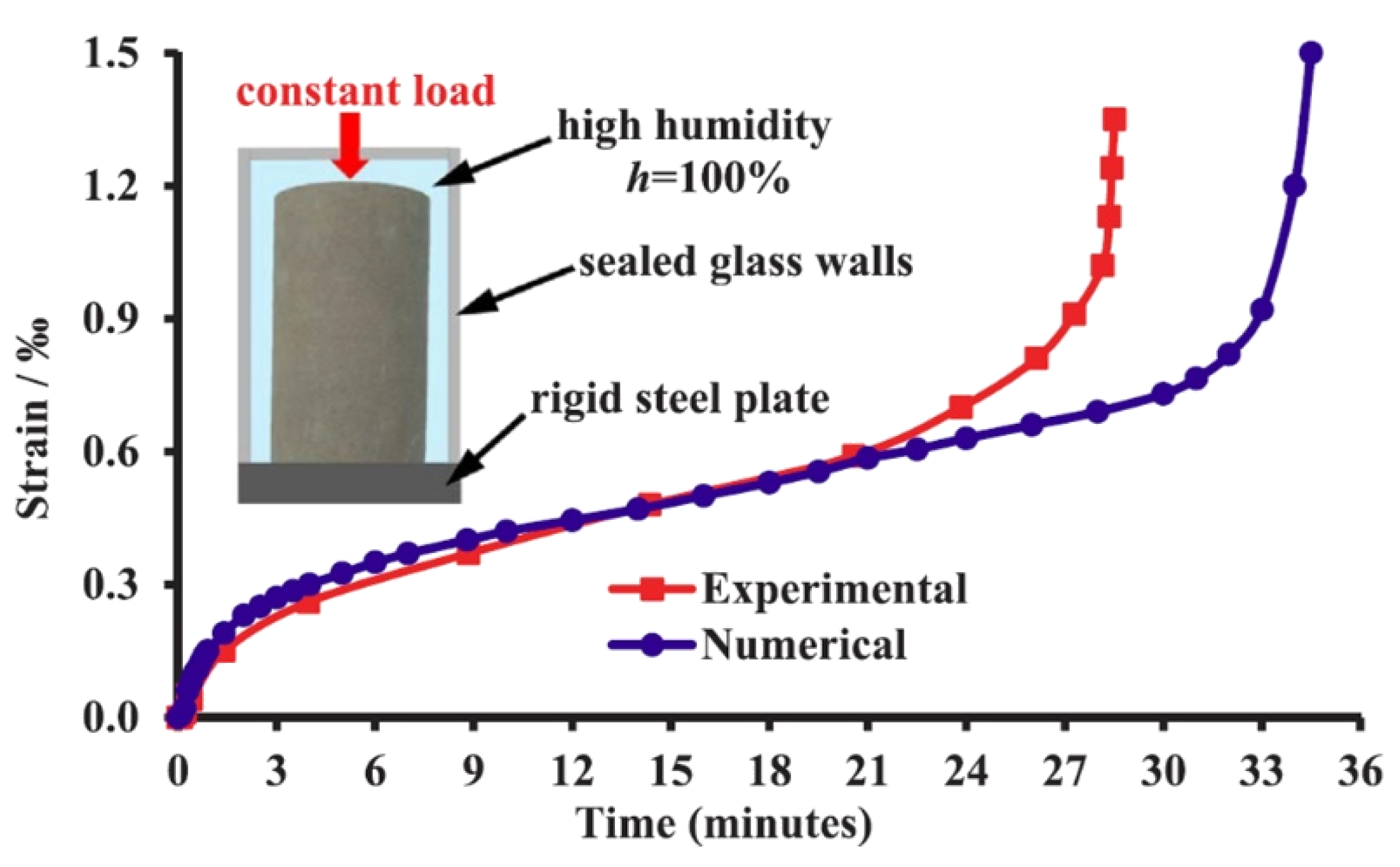



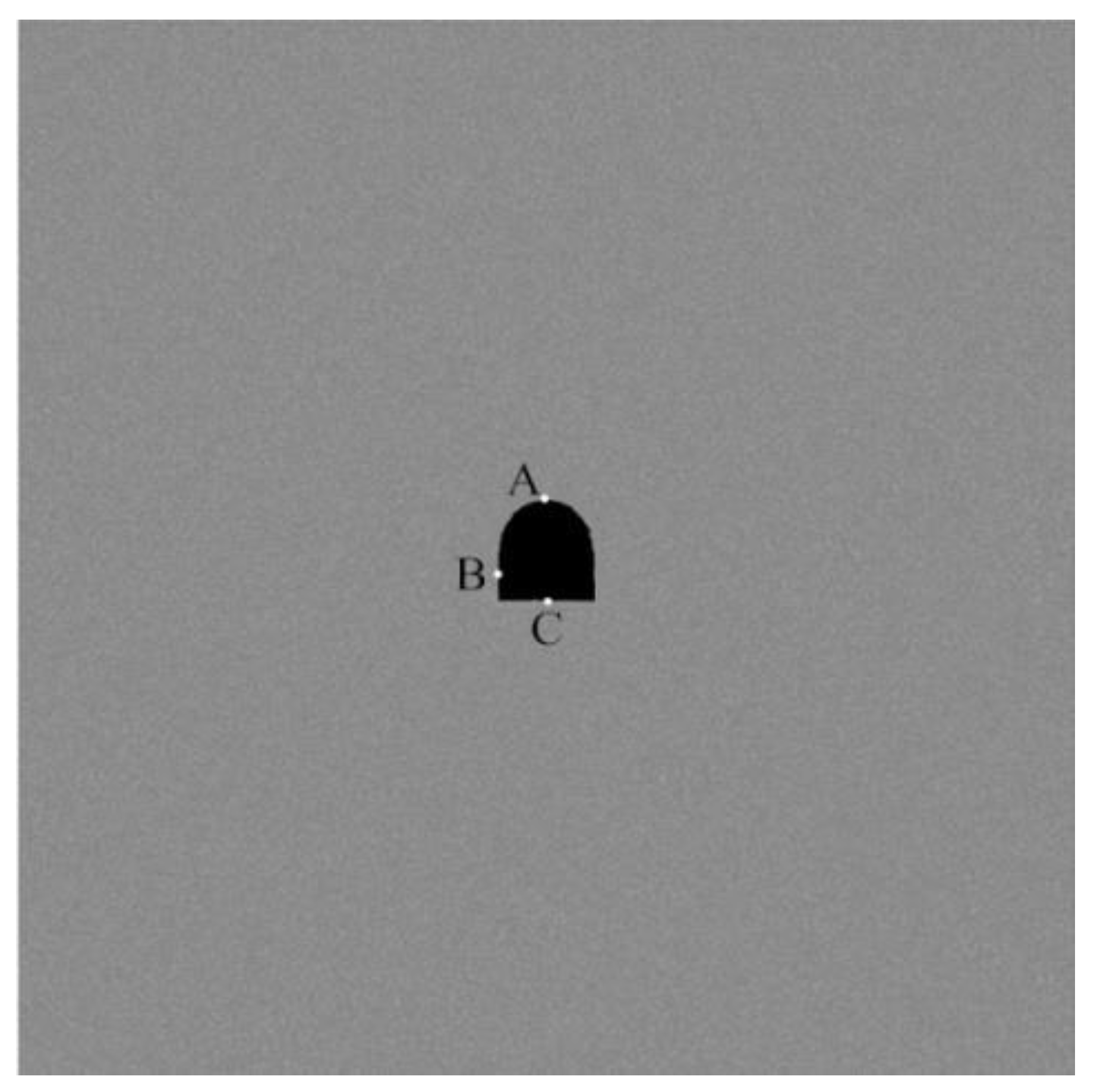
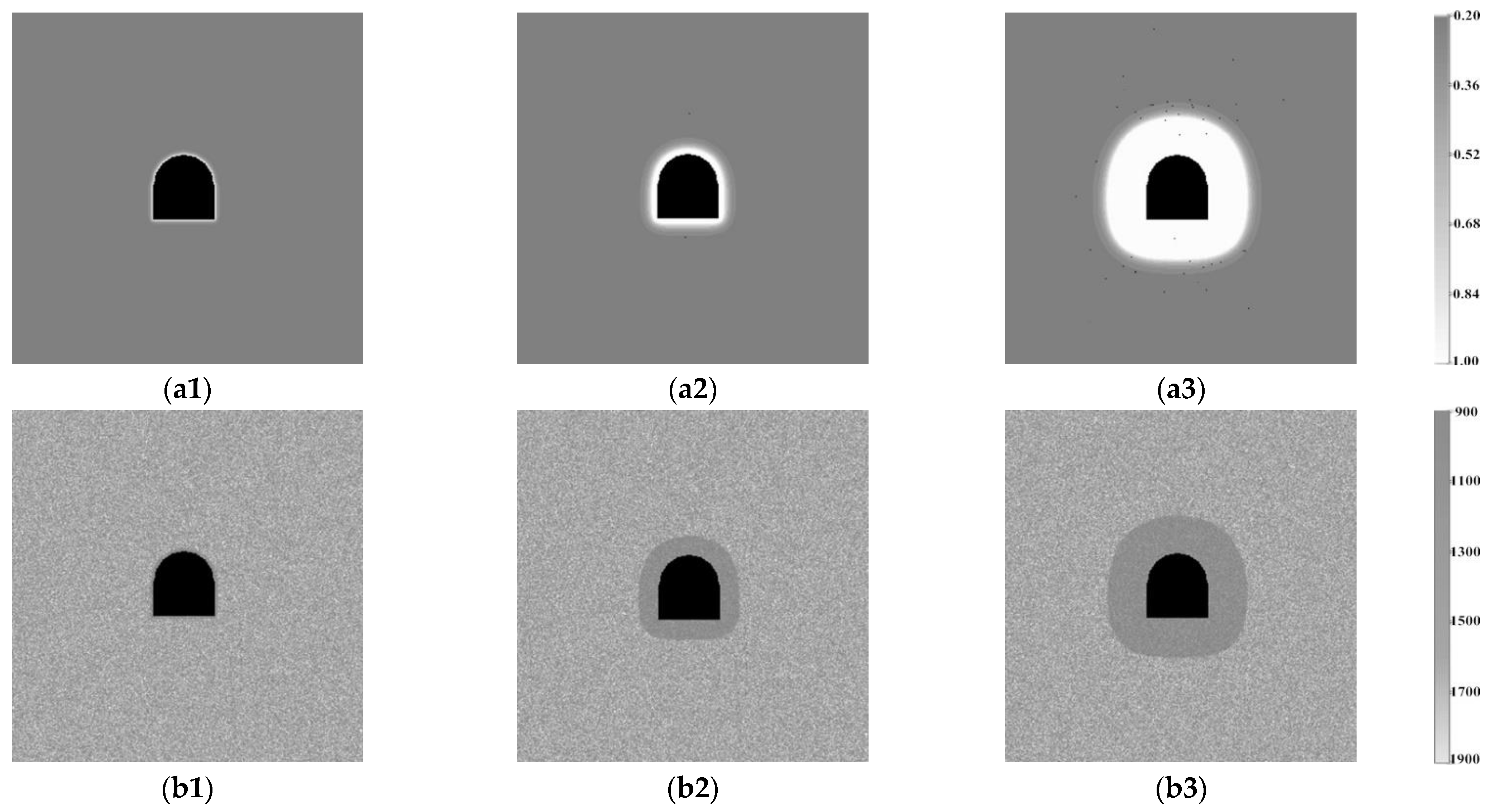


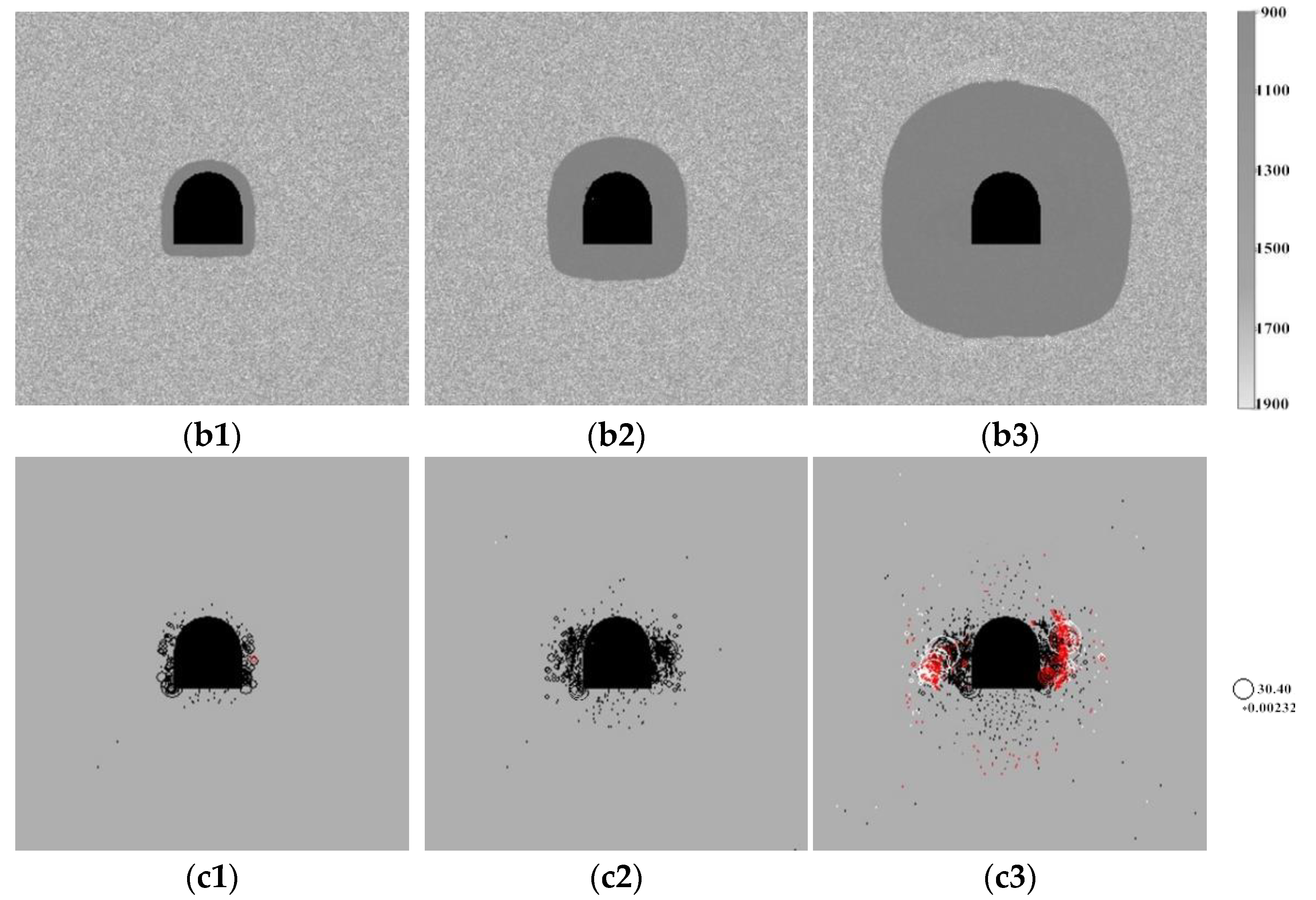
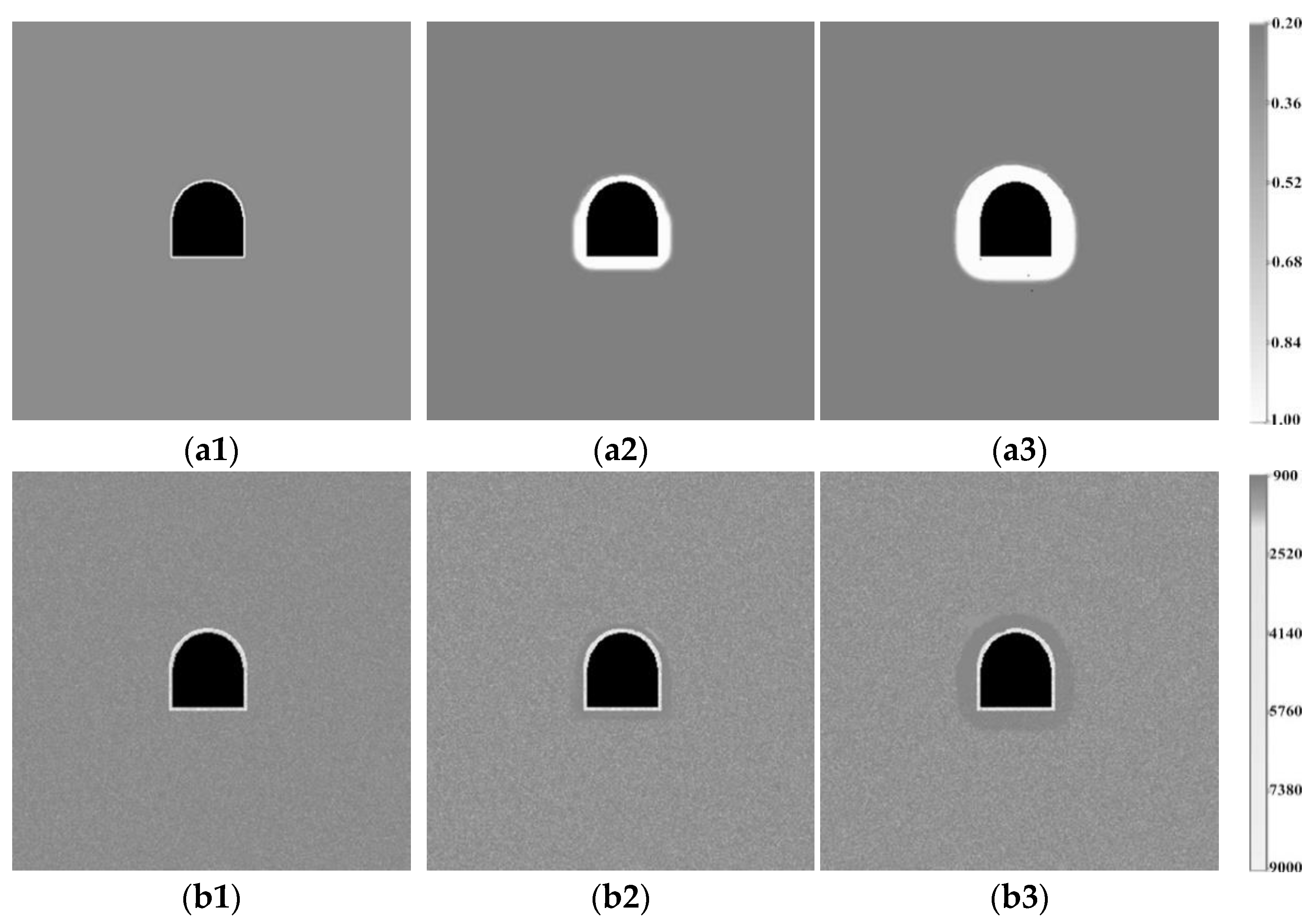
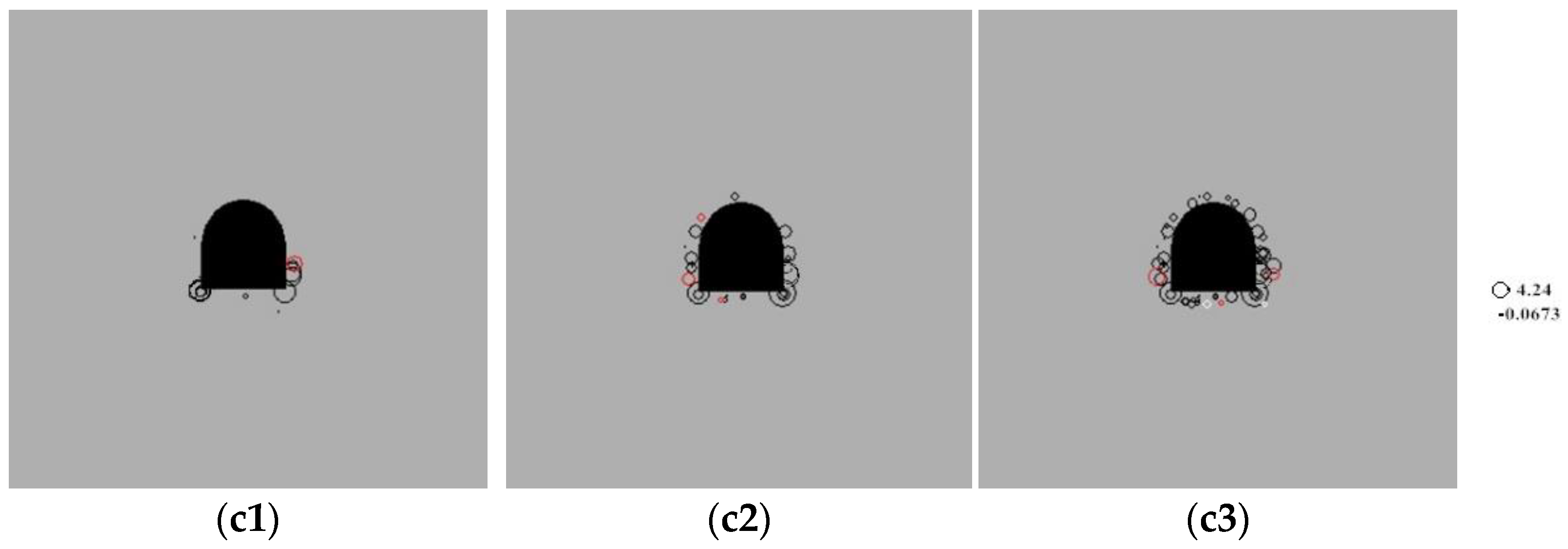
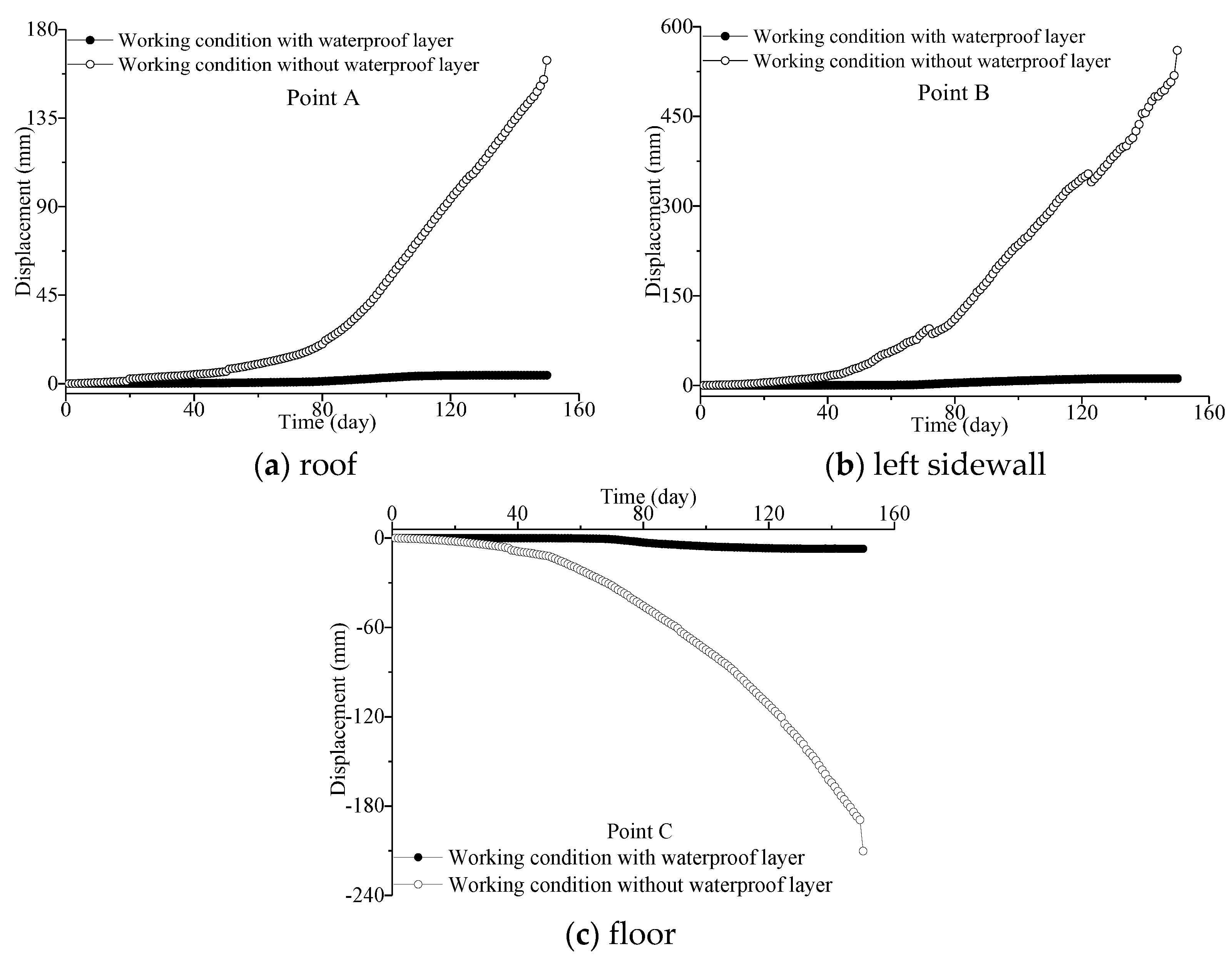

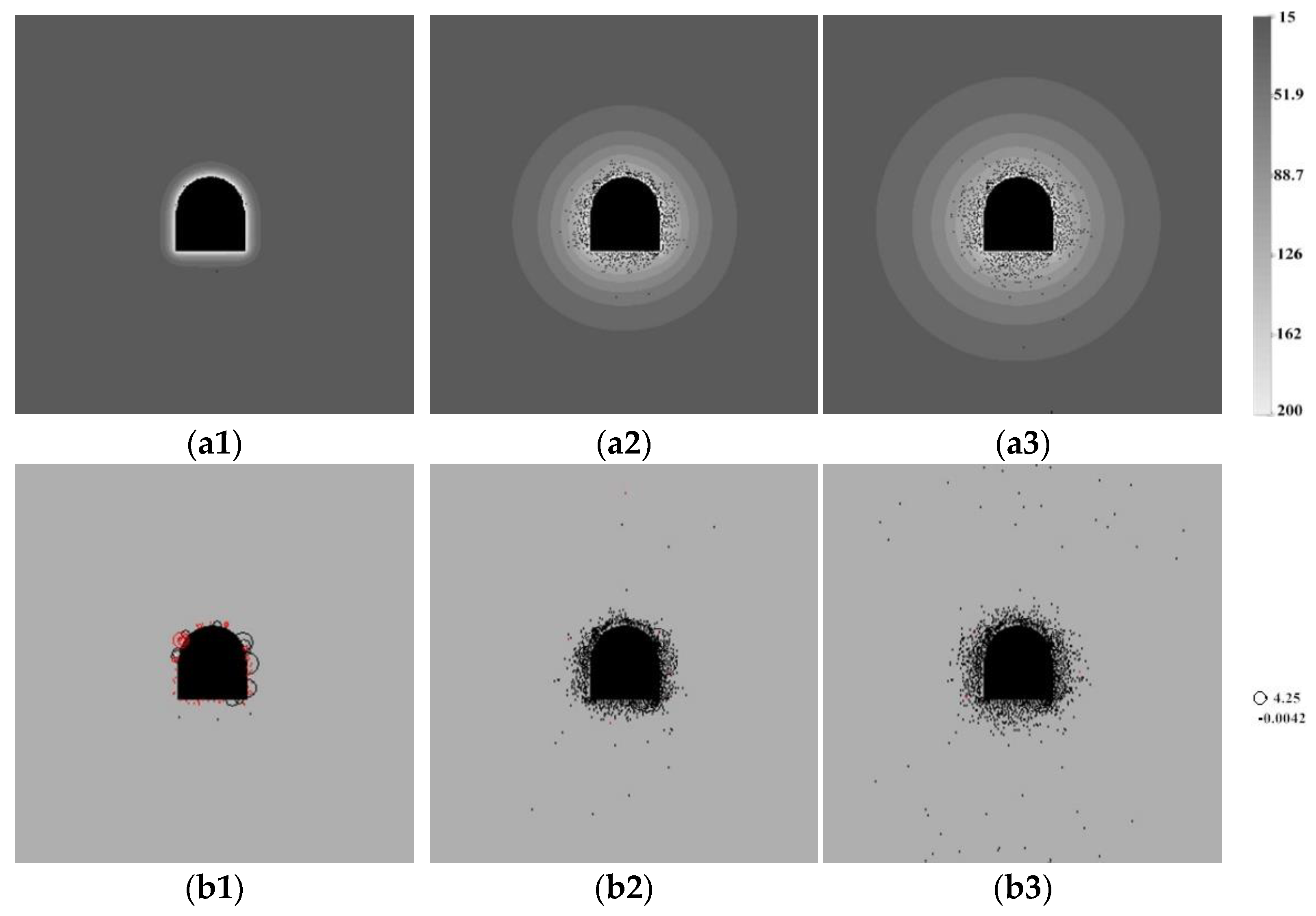


| Parameters Name | Rock Mass [8] | Water-Proof Layer |
|---|---|---|
| Elastic modulus (MPa) | 1500 | 30,000 |
| UCS (MPa) | 38.8 | 100 |
| Poisson’s ratio | 0.25 | 0.2 |
| density (Kg/m3) | 2610 | 2700 |
| internal friction angle (°) | 25 | 40 |
| Diffusion coefficient (m2/s) | 1 × 10−7 | 1 × 10−9 |
| swelling coefficient | 0.006 | 0.0001 |
| Degradation of elastic modulus | 0.6 | 0.3 |
| Degradation of strength | 0.5 | 0.2 |
| Parameters Name | Rock Mass [36] | Insulation Layer |
|---|---|---|
| Elastic modulus (MPa) | 70,000 | 100,000 |
| UCS (MPa) | 500 | 250 |
| Poisson’s ratio | 0.26 | 0.4 |
| density (Kg/m3) | 2710 | 50 |
| internal friction angle (°) | 49 | 40 |
| thermal conductivity (W/(m·K)) | 2.6 | 0.05 |
| thermal expansion coefficient (×10−5/°C) | 0.7 | 0.1 |
| heat capacity (J/(m3·K)) | 2.1 × 106 | 500 |
Publisher’s Note: MDPI stays neutral with regard to jurisdictional claims in published maps and institutional affiliations. |
© 2022 by the authors. Licensee MDPI, Basel, Switzerland. This article is an open access article distributed under the terms and conditions of the Creative Commons Attribution (CC BY) license (https://creativecommons.org/licenses/by/4.0/).
Share and Cite
Kong, X.; Wang, S.; Song, Z.; Tang, C.; Yu, C.; Chen, X. New Perspectives on Excavation Disturbance Zones: Main Driving Forces. Appl. Sci. 2022, 12, 11023. https://doi.org/10.3390/app122111023
Kong X, Wang S, Song Z, Tang C, Yu C, Chen X. New Perspectives on Excavation Disturbance Zones: Main Driving Forces. Applied Sciences. 2022; 12(21):11023. https://doi.org/10.3390/app122111023
Chicago/Turabian StyleKong, Xiangyong, Shanyong Wang, Zongwu Song, Chun’an Tang, Chaoyun Yu, and Xu Chen. 2022. "New Perspectives on Excavation Disturbance Zones: Main Driving Forces" Applied Sciences 12, no. 21: 11023. https://doi.org/10.3390/app122111023
APA StyleKong, X., Wang, S., Song, Z., Tang, C., Yu, C., & Chen, X. (2022). New Perspectives on Excavation Disturbance Zones: Main Driving Forces. Applied Sciences, 12(21), 11023. https://doi.org/10.3390/app122111023






